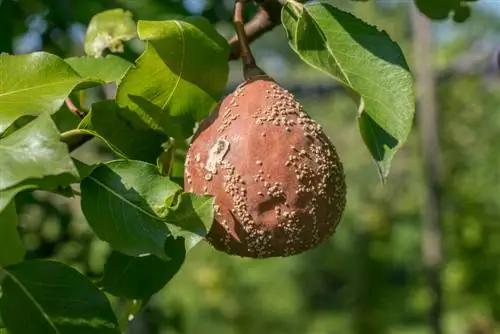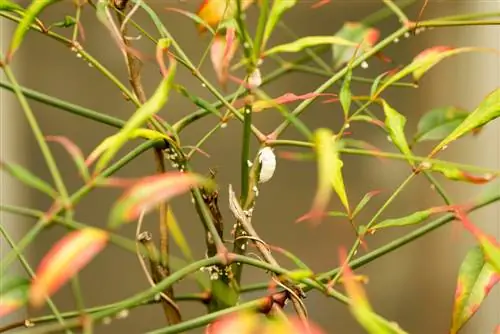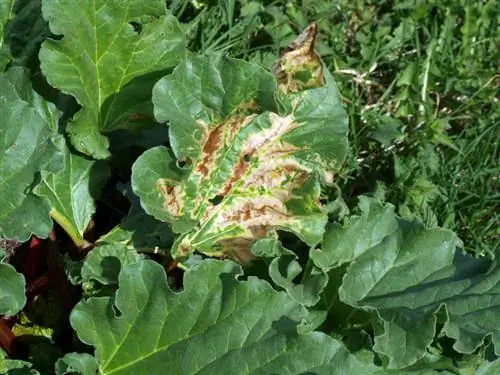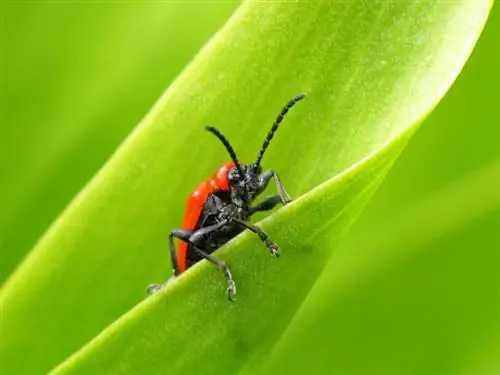- Author admin [email protected].
- Public 2023-12-26 14:17.
- Last modified 2025-06-01 06:02.
The term “Monilia” brings together different pathogens that cause dreaded diseases such as tip drought or fruit rot, primarily on fruit trees. This is how you can recognize and fight the fungi effectively with home remedies and sprays.

How do you control Monilia on fruit trees?
Monilia is a group of fungal pathogens that cause diseases such as tip drought and fruit rot in fruit trees. To combat them effectively, you should take preventive measures such as choosing a sunny location, suitable soil conditions, sufficient planting distance, regular thinning of the crown and the use of biological plant strengtheners.
- Monilia are plant diseases caused by a closely related group of fungi.
- Stone and pome fruit plants, especially sweet and sour cherries, are particularly at risk.
- Depending on the type of damage and the pathogen, a distinction is made between fruit rot and tip drought.
- Control is difficult or impossible, which is why preventive measures are so important.
Identifying Monilia - Typical symptoms and damage pattern
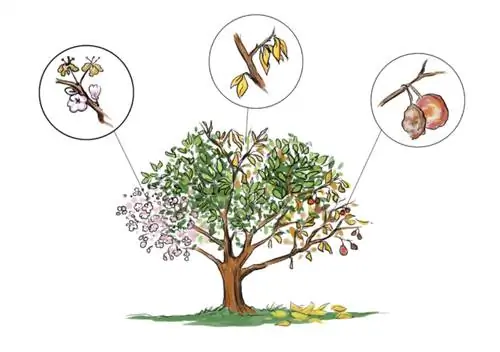
Dead shoots and twigs, dried flowers and browned, rotting fruits: Monilia disease occurs in various forms and is particularly feared by orchardists. However, it is not a single disease: Instead, “Monilia” is the generic term for fungal pathogens that are closely related, but some of which have specialized on different host plants and also cause various harmful symptoms.
Basically there are three pathogens and thus forms of Monilia:
- Monilia laxa: causes the so-called tip drought, the flowers are usually infected first, often occurs on stone fruit and less often on pome fruit plants
- Monilia fructigena: also known as Monilia fruit rot or, due to the characteristic spore pattern, as cushion mold, more common on pome fruit
- Monilia linhartiana: only appears on quinces, causes damage to leaves, flowers and fruits
Basically, all Monilia pathogens attack both pome and stone fruit plants, although certain preferences can be determined. However, there are no differences in terms of possible prevention and control measures. Remedies that are effective against peak drought also help against fruit rot and vice versa.
Monilia Lace Drought

If a tree is affected by Monilia tip drought, the flowers wither within a few days
If a plant is infected with the peak drought pathogen, this is shown by the following symptoms:
- Withering of affected flowers and neighboring leaves within a few days
- Browning of flowers and leaves
- affected parts of the plant do not fall off, but remain dry and hang on the plant
- The shoot tips die off as the disease progresses
- Shoot tips dry out over a length of 20 to 30 centimeters
- gradual balding of the treetop
- yellowish-gray spore beds on dead branch tips
- sometimes gum flow in areas between diseased and he althy wood
Tip drought is sometimes called twig monilia.
Monilia fruit rot

The Monilia fruit rot is very clearly visible
Fruit rot or fruit monilia is typically caused by rotting fruit:
- first small brown, rotting spot
- is caused by damage to the fruit skin, for example due to wasp damage or winder drilling holes
- these serve as a gateway for the pathogens to enter the fruit
- rotten spot expands quickly
- Formation of characteristic circular spore pads
- Fungus gradually colonizes the entire fruit, then the spores spread over the entire surface
Fruit infected with fruit monilia is not edible and must be disposed of, but under no circumstances in the compost! Otherwise, the pathogen can take over and spread to other trees in the compost. Always throw rotten fruit and fruit mummies that have been removed from the tree into the trash.
Excursus
Monilia black rot on apples
A peculiarity of Monilia rot occasionally occurs on apples, which is called black rot. Apples infected late in the year often begin to rot after harvest and during storage, turning completely black. In this case, however, spore deposits are rarely formed.
Cause
The cause of both branch monilia and fruit monilia are certain, closely related fungi. The infection occurs in the branch monilia in early spring, for example because
- the pathogen overwintered in so-called fruit mummies
- or dried shoots that were infected the previous year were not cut back
Fruit mummies are mostly dried fruits that either hang on the tree over the winter or fall to the ground and remain there. As temperatures rise in spring, not only do the trees sprout, the fungi also form new spores. These spread to endangered trees through wind, rain and insects (e.g. during pollination).
Once landed on a fruit tree, the pathogen penetrates the branches through the smallest injuries or through the flower stalk and from there infects flowers and shoot tips. These parts of the plant eventually dry out because the fungus clogs the ducts and interrupts the flow of water. An infestation of peak drought occurs primarily as a result of a rather cool and wet spring.
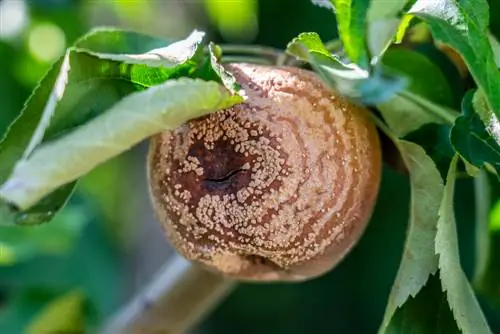
The fruit monolia penetrates the apple from the outside
Fruit monilia, on the other hand, arises because the pathogen penetrates the fruit through tiny injuries to the fruit skin and multiplies there. Here the infection does not occur in spring, but at a later point in time during fruit formation and ripening.
Excursus
Which plant species are particularly at risk?
Basically, all Monilia species occur on both pome and stone fruit plants. However, sour and sweet cherries as well as apricots are particularly susceptible to branch monilia or tip drought, although this disease only rarely occurs on apple and pear trees. Instead, apples and pears are more often affected by fruit rot, as are quinces, plums and reindeer and peaches. Cherries are also often affected, with the popular variety 'Morelle' being particularly at risk. In general, some varieties are more susceptible, while others are virtually resistant to infection.
How to effectively prevent Monilia
video: Youtube

Monilia is a very difficult infection to combat and can only be brought under control with targeted prevention. This primarily includes these measures:
| Location selection | When planting, make sure that the location is as sunny, warm and airy as possible |
|---|---|
| Suitable soil conditions | Fruit trees that grow on heavy, waterlogged soils are more likely to suffer from Monilia than trees on loose, well-drained and humus-rich substrates. |
| Maintain planting distance | Be sure to adhere to the recommended planting distance and do not plant fruit trees too close together. This is the only way the air can circulate and wet leaves and shoots can dry quickly after a rainstorm. This reduces the chance of infection. |
| Crown thinning | The same as the planting distance also applies to regular thinning of the crown - a loose and not too tight crown is less at risk of infection than one in which shoots and branches are too close together. |
| Fighting pests | Since fruit monilia in particular are often transmitted via certain pests such as the codling moth, you should definitely prevent an infestation (e.g. by turning the trunk white in autumn) or combat it with appropriate measures. |
| Strengthening the immune system | Strengthen your fruit trees' defenses against fungal infections, for example by regularly spraying and/or watering with home-made plant manure. Onions, garlic and (field) horsetail have a very good preventive effect against fungi. |
You should start spraying the plant manure in the spring before budding and repeat the application at intervals of about two weeks during the growing season. Always use fresh plant manure.
Planting resistant fruit varieties
Another preventive measure is to plant fruit varieties resistant to Monilia. The following table gives you an overview of varieties suitable for the home garden:
| Fruit | Resistant varieties |
|---|---|
| Sour cherry | 'Gerema', 'Carnelian', 'Corundum', 'Ludwigs Frühe', 'Morellenfeuer', 'Morina', 'Safir' |
| Sweet cherry | ‘Burlat’, ‘Regina’, ‘Summit’, ‘Sylvia’ |
| Plum | ‘Hanita’, ‘Katinka’, ‘Tegera’ |
| Peach | ‘Benedicte’, ‘Kernechter vom Vorgebirge’, ‘Revita’ |
Apple and apricots that are resistant or insensitive to Monilia do not currently exist (as of May 2020). For apples, the focus of breeding is on resistance to other fungal diseases; for apricots, a corresponding research project has been running since 2018.
Fighting Monilia
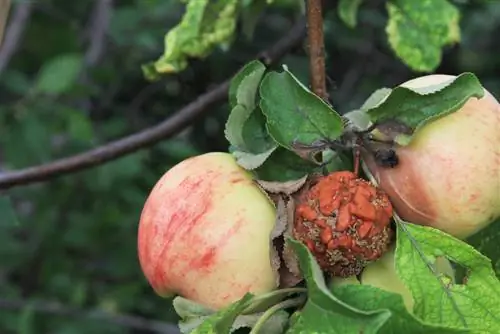
Monilia is an extremely stubborn disease
“Since Monilia is difficult to control, only targeted prevention helps with endangered trees.”
The most important control measures against Monilia are:
- Timely pruning: Peak drought can be limited by heavily pruning the diseased parts of the plant deep into the he althy wood. Cut away visibly diseased branches and shoots up to approx. 30 centimeters - at any time of the year, not just after the harvest.
- Removal of rotting fruits and fruit mummies: Do not leave rotting fruits hanging on the tree, but remove them immediately and dispose of them with household waste. The same applies to fruit mummies, which should under no circumstances remain on the tree over the winter months. Also remove any fallen fruit.
Otherwise there are no direct control measures, because once Monilia has broken out, spraying with a fungicide no longer helps. These products only have a preventive effect and must be applied in spring.
Which remedies you can inject against Monilia and when
The following overview shows you which fungicidal agent you can spray against the twig monilia and when:
- Biological plant strengtheners: preventive treatment from leaf shoots, repeat every ten days, spray directly into the flowers, suitable agent e.g. B. Neudovital
- Fungicides: preventive spraying at the start of flowering, at full flowering and when fading, also prevents an infection that has already begun, suitable products e.g. B. Duaxo Universal mushroom-free or mushroom-free Ectivo
However, there are only a few remedies approved for home gardens against fruit rot. For stone fruit, you can inject fruit-fungus-free Teldor at the first sign of an infection; for pome fruit, only copper-containing products (e.g. Atempo copper-fungus-free) are permitted, which is also used against scab.
Frequently asked questions
Can I put pruned branches infected with Monilia in the compost?
No, please do not put infected clippings as well as rotten fruits or fruit mummies in the compost, but dispose of them with household waste or by incineration.
Are there also types of fruit that are particularly at risk?
Sweet and sour cherries are considered to be particularly at risk from Monilia, with the variety 'Morelle' being very susceptible. In principle, almost all fruit trees can be infected.
How can my fruit tree become infected with Monilia?
Infection occurs through spores that are transmitted from one infected tree to another by rainwater, wind or insects. Trees that are already diseased, on the other hand, become infected again every spring via spore deposits on fruit mummies, in fallen fruit or on shoots and branches that have not been pruned.
Tip
Not only fruit trees are affected by Monilia, many ornamental trees can also be infected. This particularly affects almond trees, ornamental apples and ornamental cherries.

